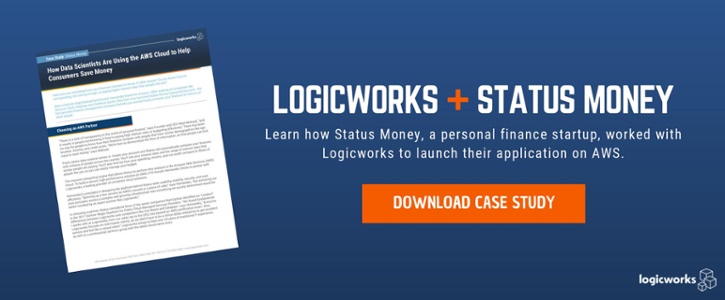“Machine learning is so tantalizing for most every day developers and scientists. Still, there are a lot of constraints for builders….How do we turn machine learning from a capability of the few, into something that many more people can take advantage of?” – Andy Jassy, Keynote from AWS re:Invent 2017
The FinTech industry has been hyped about the potential of machine learning technology for years. Despite all the noise, it’s still very early for most companies. Expert machine learning practitioners are rare, and even if you manage to find one, it usually takes more than a year to launch a machine learning app in production.
But all that’s set to change in 2018. First and most importantly, SaaS-based machine learning platforms are maturing and ready for use by FinTech companies. Equally exciting are the tools made available by Amazon Web Services (AWS) — the platform most FinTech companies are already running on — to make the process of building your own machine learning algorithms much easier.
SaaS Machine Learning Platforms for FinTech
Creating a machine learning model isn’t easy. First you have to get your data in one place, then choose an algorithm, train your model, tune your model, deploy the model, and fine-tune it over time. Given the pace of change in the industry, algorithms need to be tuned constantly. But data analysis power is not enough. The tougher job is understanding how to communicate the insights of machine learning to consumers.
Given all of these challenges, finance companies usually begin by searching for a SaaS-based machine learning platform that solves an existing challenge, rather than building their own tool. For finance companies that ingest large amounts of financial data, machine learning means using data from thousands of consumers to pinpoint investment opportunities, uncover fraud, or underwrite a loan.
Here are some of the popular SaaS machine learning apps and APIs for finance:
User Logins and Facial Recognition
User login is changing, and having usernames and passwords to access your bank account might not be around forever. Technology for facial recognition and biometrics is finally reaching the mainstream; Facebook facial recognition finds photos you’re untagged in; facial recognition cameras have been installed in apartment complexes in China to provide keyless entry; facial scanning pilot programs are currently in use in six American airports. In late 2017, Amazon released a Deep Lens, “the world’s first deep learning enabled video camera”, which will likely spur further innovation in facial recognition.
- Kairos – a “human analytics” platform for face detection, identification, emotion detection, and more. It’s already used by companies such as Carnival, Pepsico, IPG, and more.
- Luxand FaceSDK – a system that detects faces and facial features, used for building authentication, video search, and even augmented reality. Used by large enterprise such as Universal, Samsung, and Ford.
- IBM Watson Visual Recognition API – an API that allows you to tag and classify visual content, including faces.
Portfolio Management
Companies like Betterment, Mint and others have proven that millennial customers don’t need to speak with a human advisor in order to feel comfortable investing. Instead, they trust algorithms that change their investments according to market changes. These complex, machine-learning led services are taking significant market share from more traditional advisory channels.
- Responsive.ai – a platform used by private wealth managers and institutions to provide clients with a digital experience to track investments, plus automated recommendations. Also provides analytics to the wealth managers across their client base.
- BlackRock Aladdin Platform – an end-to-end investment platform that combines risk analytics with portfolio management and trading tools.
- Clinc – a conversational AI platform for personal banking. Clinc can provide wealth managers’ clients with personalized insight into spending patterns, notify customers of unusual transactions, and recommend new financial products.
If you’re interested in learning how to build a machine learning portfolio management platform in-house, read this fascinating article about Man Group, which built its own AI tool and even has its own Institute at Oxford to experiment with different AI-built trading systems.
Fraud Detection
According to the Association of Certified Fraud Examiners, the money lost by businesses to fraud is over $3.5 trillion every year. Machine learning-based platforms help warn companies of potential fraudsters or phishing attacks in real time.
- Kount – A platform that allows you to identify fraud in real time. Kount AI Services combines their core platform with custom machine learning rules developed by their data science team.
- IBM Trusteer – IBM’s Pinpoint Detect is a cloud-based platform that correlates a wide range of fraud indicators to detect phishing attacks, malware, and advanced evasion methods. It also learns each customer’s behavior across multiple sessions to help identify when fraudsters assume that customer’s identity.
Still Want to Build Your Own? Machine Learning on AWS
Finance companies that want to build proprietary machine learning algorithms will not be satisfied with a one-size-fits-all SaaS tool. If you want to build your own machine learning app, AWS can significantly reduce the amount of time it takes to train, tune, and deploy your model.
AWS has always been at the forefront of machine learning; think of Amazon’s recommendation engine that displays products that customers like you have purchased, or Amazon Echo, the popular voice-controlled smart home hub. They’ve released a series of machine learning tools over the past 3 years for their AWS customers, including the technology behind Echo’s Alexa.
At re:Invent 2017, Amazon released a service that packages together many of their previously-announced machine learning capabilities into an easy-to-use, fully-managed service: AWS SageMaker.
SageMaker is designed to empower any developer to use machine learning, making it easy to build and train models and deploy them to production. It automates all the time-consuming training techniques and has built-in machine learning algorithms so you can get up and running quickly. Essentially, it’s one-click machine learning for developers; you provide the data set, and it’ll give you some interesting outputs. This is a big deal for smaller companies without a fleet of data scientists who want to build machine learning applications. Granted, developers still have to understand what they’re doing and apply that model in a useful way to your customers.
Machine learning will continue to be a huge force in finance in 2018. As the market matures, expect more SaaS products and more platforms like AWS SageMaker that ease adoption of machine learning.
If you want to build a machine learning platform on AWS but need some expert help to migrate data and set up your applications, contact Logicworks. We work with companies like MassMutual and Thomson Reuters to build secure, compliant AWS cloud environments.



No Comments